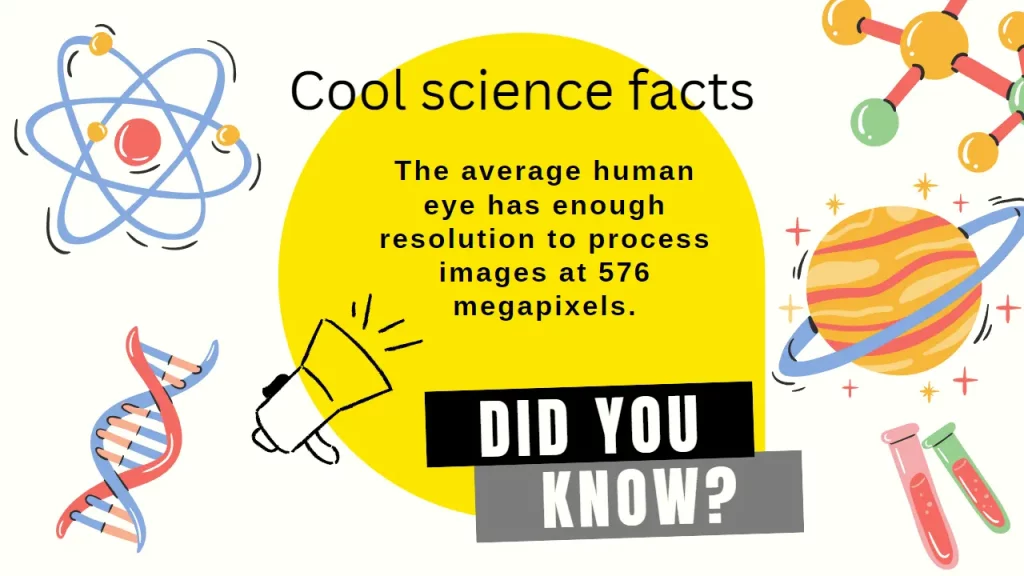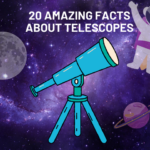Science and technology are two fields that are closely related, yet distinct. Science is the systematic study of the natural world. It is a way of understanding how the world works, from the smallest particles to the largest structures in the universe. Science is also a way of solving problems and answering questions. Scientists use the scientific method to ask testable questions, design experiments, and analyze data.

We all know that science is amazing, but sometimes it’s hard to see just how cool it really is. That’s why today I’m bringing you cool science facts that will blow your mind! From the bizarre to the awe-inspiring, these are some of the cool and interesting facts in science that will make you think, “wow!”
Table of Contents
20 Interesting Facts about Science
- You may not realize it, but you are more bacteria than humans. In fact, only 43% of the cells in your body are actually human. The rest are made up of bacteria, viruses, and fungi. The majority of these microbes live in our gut, where they help us to digest food and fight off infection. While some bacteria can cause disease, the majority of them are actually beneficial to our health. In fact, we would not be able to survive without them.

- The average human eye has enough resolution to process images at 576 megapixels. But we only see at a resolution of 150 dpi because that is more than enough visual information for us to recognize items. The human eye is able to see a wide range of colors and detail because of the high number of photoreceptor cells in the retina. The retina is a thin layer of tissue at the back of the eye that contains photoreceptor cells that sense light and send signals to the brain. The intensity of light that hits the retina determines how much information is sent to the brain.
- Laika was a small dog who made history when she became the first animal to orbit Earth. Laika was launched into space aboard the Soviet spacecraft Sputnik 2 on November 3, 1957. Unfortunately, Laika did not survive the journey and died 7 hours after launch. While her death was tragic, her legacy continues to inspire future generations of space explorers. Today, we honor Laika’s memory by striving to push the boundaries of space exploration and keep her dream of reaching the stars alive.
- When one donates his or her body to science, it can be used for a number of purposes. For example, your body can be used as a crash test dummy to help researchers develop safer cars. Or it can be used as a cadaver for medical training, helping future generations of doctors to learn and perfect their skills. Additionally, your body can be used as a specimen for forensic research, providing valuable data that can help solve crimes. Finally, your organs can be donated for transplantation, potentially saving the lives of other people. So if you’re considering donating your body to science, know that it could have a major impact.
- Did you know that the stomach is also capable of dissolving razor blades? It’s true! At first glance, the human stomach seems like a pretty tough organ. After all, it’s designed to digest some pretty tough things, from chewing gum to chicken bones. The stomach is filled with powerful acids that break down food into its nutrient components. These same acids can also break down other materials, including razor blades. So, if you swallow a razor blade, it’s likely that it will eventually be dissolved by the acids in your stomach. Of course, this doesn’t mean that swallowing razor blades is a good idea. The stomach is a strong organ, but it’s not indestructible. Swallowing a razor blade can damage the lining of the stomach, leading to serious health problems. So, while the stomach is capable of dissolving razor blades, it’s best to avoid putting it to the test.
- Earth’s atmosphere is 21 percent oxygen, and almost all of that oxygen comes from the ocean. The main source of this oxygen is marine plants, specifically phytoplankton, which produce oxygen as a by-product of photosynthesis. These microscopic plants float near the surface of the water and are constantly absorbing carbon dioxide and releasing oxygen. In addition to phytoplankton, algae and seagrasses are also major contributors to the Earth’s oxygen supply. Together, these three groups of marine plants produce more than 98 percent of the planet’s oxygen.
- Animals have an amazing ability to orient themselves using the Earth’s magnetic field. This ability is known as magnetoreception, and it allows animals to sense the direction of the magnetic field and use it for navigation. Magnetoreception is found in a variety of animals, including birds, fish, turtles, and even some insects. The ability to detect the magnetic field is thought to be mediated by special cells in the body that contain iron-containing particles.
- Did you know that a cloud can weigh around a million pounds? That’s right – a single cloud can be packed with enough water to weigh over 500 tons. And when you consider that there are billions of clouds in the sky, it’s no wonder that they play such an important role in the water cycle.
- When rats are tickled, they actually laugh. A study found that rats emit a unique vocalization when they’re enjoying themselves, which the researchers dubbed “laughing.” The researchers discovered that this sound is produced by a different set of vocal cords than the ones used for other vocalizations, such as screams of pain or distress. When rats were tickled with a feather, they would produce a high-pitched sound that was similar in some ways to human laughter. This sound was accompanied by changes in breathing patterns and body movements that are also seen in humans when we laugh. Interestingly, the rats only produced this sound when they were tickled by another rat; when tickled by a human hand, they remained silent.
- Though often thought of as a healthy, innocuous fruit, bananas are actually quite radioactive. This is due to the presence of potassium-40, a radioactive isotope of potassium. Though the human body needs potassium to function properly, too much potassium can be dangerous. Fortunately, the amount of radiation found in a single banana is relatively low and poses no significant health risk.
- You might have noticed that hot water seems to freeze faster than cold water. This phenomenon, known as the Mpemba effect, is named after a Tanzanian student who observed it while making ice cream. Though the Mpemba effect has been known for centuries, scientists are still not sure why it occurs.
- It may come as a surprise to learn that just six minutes after consuming alcohol, brain cells begin to react to the presence of the substance. This was the discovery made by a 2009 study, which set out to investigate the short-term effects of alcohol on brain cells. Using MRI scans, the researchers found that alcohol consumption decreases the levels of creatine and choline in the brain. This could explain the long-term brain damage observed in alcoholics, as it appears that alcohol has a direct impact on brain cell function. While further research is needed to confirm these findings, the study provides a fascinating insight into the complex relationship between alcohol and the brain.
- At first glance, it might seem impossible that there could be more trees on Earth than stars in our galaxy. After all, galaxies are vast collections of billions of stars, while the number of trees on our planet is finite. However, recent estimates suggest that there are actually more trees on Earth than there are stars in the Milky Way. This is because galaxies are mostly empty space, while the majority of the Earth’s surface is covered in vegetation. In other words, while galaxies may be larger in size, they are not nearly as dense as our planet. So the next time you’re feeling overwhelmed by the enormity of the universe, just remember that there are more trees on Earth than there are stars in the sky.
- It may come as a surprise to learn that humans have genes from other species. In fact, we share a common ancestor with all other living beings on Earth. Over the course of millions of years, our ancestors acquired new genes through a process known as horizontal gene transfer. This occurs when DNA is transferred between two organisms that are not directly related. As humans evolved, they acquired genes from viruses, bacteria, and even plants and animals.
- Helium is a gas that is well known for its use in balloons, where it floats due to being lighter than air. However, what most people don’t know is that under the right conditions, helium can actually work against gravity. When cooled to near absolute zero, helium turns into a superfluid. In this state, it can climb up the sides of a container and even drip down upside-down.
- Have you ever wondered why you can’t burp in space? It turns out that there’s a very simple explanation. Burping occurs when gas is released from the stomach through the mouth. In order to burp, you need gravity to help push the gas up and out of your system. Without gravity, the gas simply stays in your stomach, causing bloating and discomfort.
- Most people believe that bones are the strongest tissue in the human body, but they may be surprised to learn that tooth enamel is actually even stronger. This tough, white substance protects the teeth from the everyday wear and tear of chewing and biting. While tooth enamel is incredibly strong, it is not indestructible. It can be worn down by acidic foods and drinks, as well as by aggressive brushing. Once it is damaged, it does not grow back, so it is important to take good care of your teeth to protect this important tissue.

- Bats don’t usually get sick from most viruses. However, they can still contract and spread viruses. This is because their bodies are able to resist most viruses, but the viruses can still replicate in their bodies. As a result, bats can act as carriers for diseases, even if they don’t get sick themselves. While this may seem counterintuitive, it’s important to remember that not all viruses cause sickness in all animals. In some cases, an animal can be perfectly healthy and still spread a disease to others.
- It is hard to believe that the father of electricity, Michael Faraday, lived his childhood in poverty. At the age of 13, he was compelled to work in order to survive since his father was sick and unable to do so. Despite these humble beginnings, Faraday still went on to make groundbreaking discoveries about electricity that have shaped our understanding of this essential force.
- Most people are aware that blood is essential for life, but few know exactly how much blood they have in their bodies. The average person has around 5 liters of blood, and losing 40% of this fluid will result in death. Fortunately, medical science has advanced to the point where transfusions can be performed quickly and effectively. However, it is still important to take steps to prevent excessive blood loss.
10 Cool Science Facts You May Not Know
- The human skeleton is made up of 206 bones, but this number is not set in stone. Babies are born with around 300 bones, which fuse together as they grow.
- The Eiffel Tower is one of the most iconic structures in the world, and it’s also one of the most popular tourist destinations in Paris. But did you know that the tower can actually be 15 cm taller during the summer? This is because the metal structure expands in the heat, and as a result, the tower can grow by up to 6 inches during peak summer months. However, don’t worry, the tower is designed to handle this expansion, and it will shrink back down to its normal size once the temperature starts to drop again.
- Did you know that Hawaii is slowly but surely moving closer to Alaska? It’s true! The Hawaiian Islands are actually on the move, at a rate of about 7.5 cm per year. But don’t worry, they’re not going to end up in the Arctic anytime soon. In fact, at their current rate of movement, it would take them around 50 million years to reach Alaska!
- If you’re trying to spot a polar bear in the wild using thermal imaging, you might have a hard time. That’s because these animals are nearly undetectable by infrared cameras. Polar bears are experts at conserving heat. They have a thick layer of blubber under the skin, and their dense fur coat helps them endure the coldest Arctic temperatures. As a result, they don’t give off much heat, making them very difficult to spot with thermal imaging.
- The Earth is surrounded by a magnetic field. This field is created by the Earth’s iron core, which generates electric currents. The field protects the Earth from the harmful effects of the Sun’s radiation. It also affects the path of charged particles, such as the electrons in your TV screen, which is why a compass points north.
- Did you know that Venus is the only planet in our solar system that rotates clockwise? That’s right – while all of the other planets spin counterclockwise, Venus spins in the opposite direction.
- It’s hard to believe, but the average person walks the equivalent of five times around the world in their lifetime. That’s a lot of steps! Of course, this number will vary depending on how much a person walks every day.
- Humans and dolphins are the only two species on Earth that have sex for pleasure. All other animals mate strictly for reproduction.
- Have you ever wondered where grasshoppers hear from? Most people would assume that they hear from their large, bulging eyes. However, did you know that they actually have ears in their bellies? It’s true! These special hearing organs are known as tympanal organs, and they are located just below the surface of the grasshopper’s abdomen.
- It’s estimated that 99% of all the species that have ever lived on Earth are now extinct. That means that for every one million species that have ever lived, only 10,000 are still around today. The exact number is impossible to know for sure, but it’s safe to say that the majority of life on this planet has been snuffed out.
Who knew that there were so many interesting science facts out there? We hope you enjoyed reading these fascinating facts and that you learned something new! If you’re interested in learning more, be sure to check out our blog for more interesting articles just like this one.





